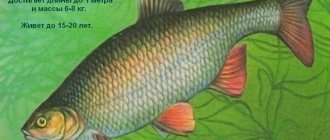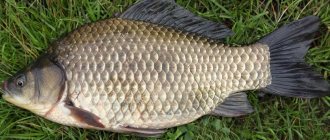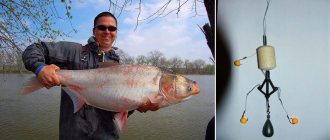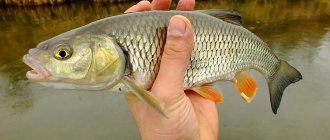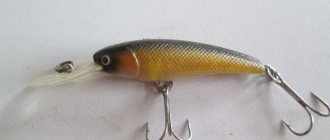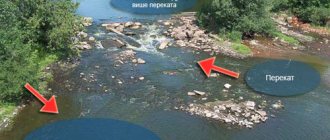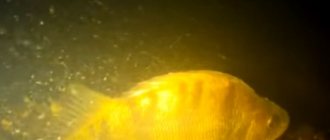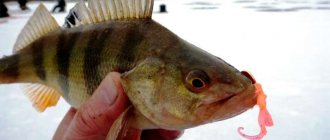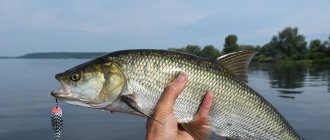River perch is a predatory fish. Its distinctive feature is the almost black transverse stripes that stand out among the yellow-green body. The back of the perch has two gray-green fins; The pectoral and pelvic fins are yellow-red in color. Catching perch with a spinning rod can be a very exciting experience. And to make perch fishing not only interesting, but also fruitful, it will not be superfluous to familiarize yourself with the factors influencing the catch. You can learn the knowledge necessary when fishing for predators from our article.
Rod selection
A spinning rod is a sports tackle designed for catching fish with bait. To choose the right spinning rod, you should pay attention to three main characteristics of the rod: test, action and length. Below we will analyze each of them in detail.
What is a test?
The spinning test is a characteristic that indicates the permissible minimum and maximum weight values of the bait.
This indicator should not be ignored. If the spinning test is greater than the weight of the selected bait, then the sensitivity of the gear will be reduced. If, on the contrary, the weight of the bait is greater, your spinning rod may break under increased load.
Manufacturers classify spinning rods according to their permissible weight:
- Ultralight / Ultralight - permissible weight: up to 7 grams.
- Light (Light) – permissible weight: up to 10.5 grams.
- Medium Light – permissible weight: from 4 to 17 grams.
- Medium – permissible weight: from 18 to 21 grams.
- Medium Heavy – permissible weight: up to 28 grams.
- Heavy – permissible weight: from 35 to 42 grams.
- Extraheavy – permissible weight: over 42 grams.
Ultralight and lightweight spinning rods are recommended for catching small perch. With the choice of a spinning rod of this class, even the lightest bite will be noticeable. Accordingly, Medium Light and Medium are suitable for medium-sized perch.
What is the optimal system?
Construction is an important characteristic. It talks about what shape the spinning rod bends during casting.
Both the accuracy of casting a lure or bait, the distance, as well as the smoothness, sensitivity of wiring, hooking a perch and depreciation depend on this indicator.
Classification of fishing rods by action:
- Very fast (Extra fast) – when loaded, the main bend occurs in the first quarter of the whip, quick return to its original state
- Fast – when loaded, the main bend occurs in the first third of the blank, quick return to its original position
- Medium – under load, the main bend occurs in the first half of the form, the time to return to the starting position is average
- Slow – when casting, the entire rod bends completely, slowly returning to its original state
The most optimal choice would be a medium action spinning rod. It is equally good for both beginners and experienced anglers.
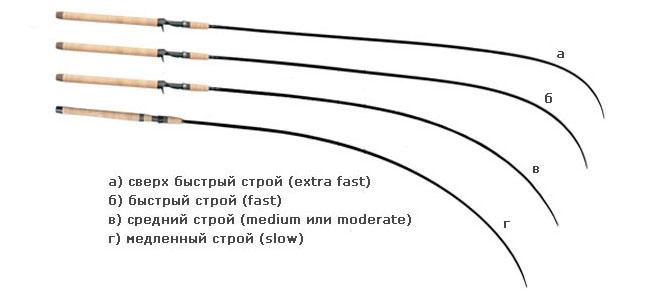
Optimal length of spinning rod
Initially, the length of the fishing rod was measured not in centimeters, but in feet (1 foot - 30 centimeters). Therefore, even now you can notice that the difference between the lengths of spinning rods is 30 centimeters, for example, 180, 210, 240 cm. In order to decide on a fishing rod, you need to know in advance where you plan to go fishing.
When fishing in a place with bushes or a high bank, you should take a spinning rod with a length of 210 cm. If you plan to fish in places with an open bank, then prefer a rod of 270 cm. When fishing for perch from a swimming device, the same 210-240 cm is enough .
The universal length is 2.4 meters.
Top 3 best universal spinning rods:
- Maximus Legend X. This is a budget fast-action spinning rod, its test weight ranges from 5 to 21 grams, length – 2.44 meters.
- Pontoon 21 Seven Eleven. It also has a fast action and medium dough - from 8 to 24 grams. The length is 2.41 meters.
- Salmon Team Neolite. This spinning rod is also fast in action, its test weight ranges from 6 to 28 grams, and its length reaches 2.35 meters.
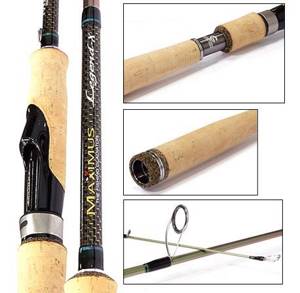
Maximus Legend X. Average price 5,700 rubles.
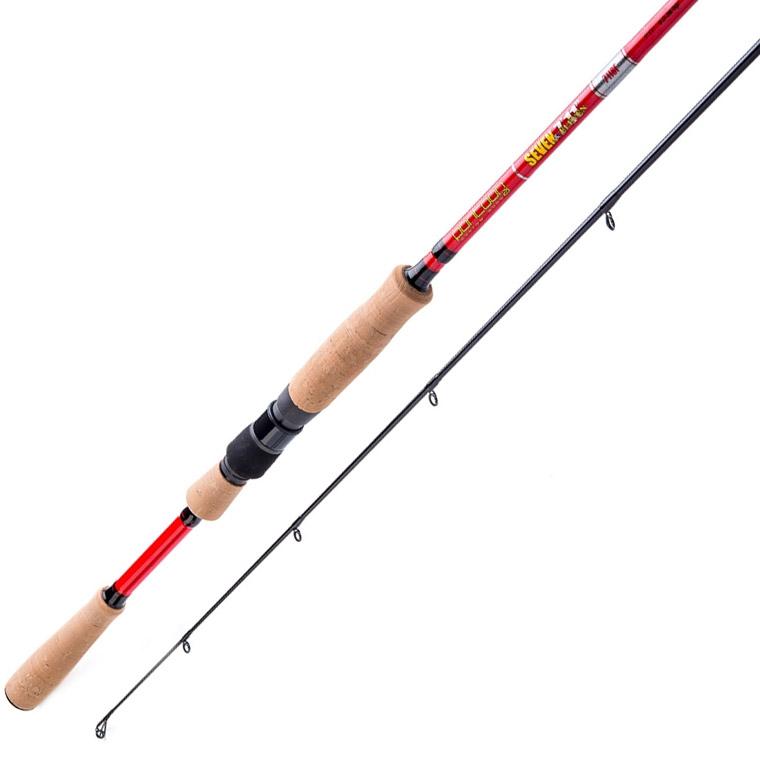
Pontoon 21-Seven Eleven. Price from 10,800 rubles.
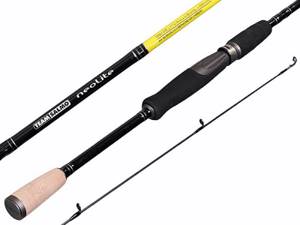
Salmon Team Neolite. The price is around 7900 rubles.
Coil selection
Inertia-free open reels are considered the most convenient for catching perch. They have a number of advantages:
- The inertia-free reel allows you to adjust the rewinding speed: from very slow to fast;
- Allows the use of very light attachments;
- Casting a spinning rod is carried out over longer distances;
- Helps prevent line breakage.
The only drawback of the inertia-free open reel is its price. But despite its high cost, the reel is completely worth it. The most optimal size is 1500. This reel is suitable for spinning with any test.
The best spinning reels for catching perch with a spinning rod:
Among our ratings, two manufacturers of reels and other fishing accessories are highlighted: Daiwa and Ryobi , which have long established themselves in the market for their quality.
- The best spinning reel is considered to be the Daiwa TD-SOL. It has a system of absolute balancing and instant braking, as well as a system that prevents line twisting.
- Next on the list is the Ryobi Ecusima 6. It has a very sensitive brake. The rocker mechanism allows you to wind the fishing line in even turns.
- Rounding out the list is the Ryobi Excia. Has a high sensitivity brake. And the push-button system for collecting the handle will be as convenient as possible to use.
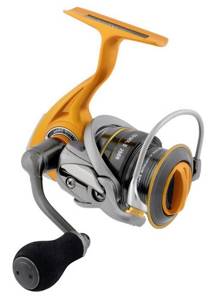
Daiwa TD-SOL
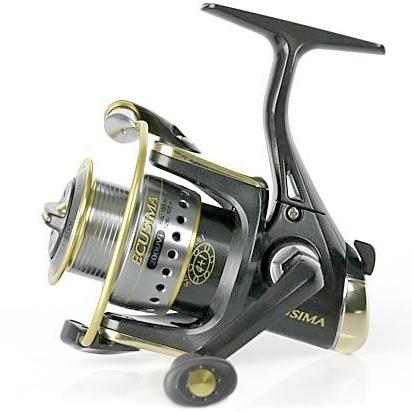
Ryobi Ecusima 6
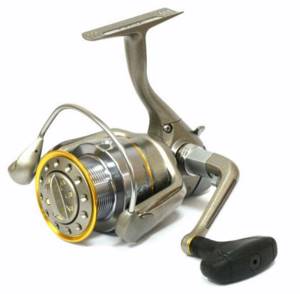
Anglers are often faced with a choice: buying fishing line or braided cord. Both options are suitable for catching perch with a spinning rod. Braided cord, compared to fishing line, has higher strength. But at the same time, it allows the perch’s lip to rupture. Also, the cost of the cord is an order of magnitude higher than the price of the fishing line, but it is fully justified by the strength and rigidity of the braid.
Rod equipment
When fishing for perch, the equipment of the rod is also important. After all, if you choose too thin a fishing line and at the same time heavy equipment, then a breakage can easily occur when biting.
Line selection
It’s worth taking a closer look at the choice of fishing line.
It’s better not to save money and purchase high-quality braided wire from Japanese manufacturers. To catch perch, you can use both fishing line and braided cord. Both should be chosen with a breaking load of 2.5-3 kilograms. The fishing line and braid themselves are very rigid, which has an extremely negative effect on the performance of the bait. Therefore, the use of leashes is mandatory. They should be no longer than 40 centimeters.
Use fluorocarbon line leaders. It is almost invisible to fish in the water.
Which spinning rod is suitable for the striped robber
- Ultra Light is the most delicate tackle. Used for super light lures: micro jigs or micro oscillators.
- Light is universal. Its use is possible with a huge range of bait weights, ranging from light to quite heavy. It is also used for jigging, with the Extra Fast action condition. The advantage of these rods is that the main working baits weigh from 3-15 grams.
Depending on fishing from a boat or fishing from the shore, the length of the rod is selected. The main objective in the first option is convenience and compactness. When fishing with a partner, it is very important to have a short rod that will not get in the way of both you and your friend. In this case, it is also more convenient to cast with a short stick. A length of 1.80 cm is more than enough for this.
The universal length is 2.10 m, allowing you to fish both from the shore and from a boat. On narrow rivers overgrown with trees and bushes, it is better to use short rods that allow you to pass through the coastal thickets. Long spinning rods are used only if the process will take place on a large surface of water, with long casts. Only in this case will the use of fishing rods with a length of 3.0-3.60 m be justified.
If you want to approach the issue professionally, so to speak, then do not buy universal options. For one type of fishing (jigging), you can take a softer stick, which allows you to feel the movement of the gear. In this case, it often looks like “noodles”. When fishing with wobblers or spinner baits, you should use something tougher. For fishermen, noodles mean a slow action, where almost the entire spinning rod reacts during the swing.
Suitable reel
We will not name specific brands, so that you do not consider this to be advertising. In addition, the choice is huge; a lot of manufacturers offer fishermen decent “meat grinders”. First of all, start from the weight and size of the spinning rod. It is advisable, if you already have a spinning rod, to take it with you to the store and hang a reel on it. Check the weight to balance ratio this way.
Obviously, a delicate and light reel is unlikely to be suitable for a bulky fishing rod; the same goes for a heavy meat grinder on an ultralight spinning rod. The weight of the reel varies depending on the size of the spool: the more line or cord it holds, the heavier it is in the end. To catch perch, you don’t need huge fishing poles that can hold 300 meters of line.
For ultralight they put size 1000, and for light up to 2500. The weight is also affected by the material of manufacture, but the stronger and lighter it is, the more expensive the reel will ultimately be. There are no more special recommendations, since you can use both overt China and famous brands, everyone will choose according to their wallet and capabilities.
Fishing line and braided cord
The fishing line has a percentage of elongation and the higher it is, the stronger it stretches during a bite. This property is well suited for those cases when it is very important not to let the fish escape due to rare bites. Thanks to depreciation (due to stretching), there are slightly fewer derailments.
When jigging or any other type of fishing where jerks are used, the fishing line is not suitable. Extensibility will interfere with the correct action of the bait, and will also not allow for clear jerks, which are necessary when catching perch with a popper. Using leashes is everyone's business, but there are a few things to keep in mind.
Often, larger predators, such as pike, bite on perch baits. It can easily bite through fishing line or thin braided cord. If there are few pike in the reservoir where you are fishing, then there is nothing to worry about, since the perch does not have a lot of sharp teeth, and its weight and agility are completely different.
But there are times when the striped fish is wary and approaches the bait with great caution, seeing a braided line in the water. In this case, it is reasonable and justified to knit a fluorocarbon leash. If the fish is active, then it cannot be spooked by either a leash or a cord.
Wobblers that catch 100%:
Shimano FX
More details
Shimano FX
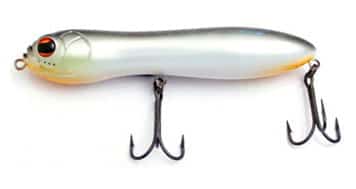
More details
Shimano FX
More details
Shimano FX
More details
Bait selection
Spinners
Spinning spoons, or spinners, are the most effective lures for catching bass.
When choosing a spinner, you should pay attention to spinning baits with large petals. They are the ones that most often attract predators at great depths. Rotators with a small blade but a decent weight are used less often. Light weight spinners are suitable for fishing in shallow water and coastal areas. The color of the bait depends on the weather. On sunny days, give preference to dull, non-shiny models. And on cloudy days, choose bright lures - golden or silver.
Oscillating spoons
Unlike spinners, oscillating spoons attract passive perches. Their peculiarity is that the oscillators create low-frequency vibrations with their play. For perch, it is better to choose S-shaped spinners. For larger perch, you should choose spoons larger than 5-6 cm.
This bait should be used in places where long runs can be made.
The choice of oscillators, as well as turntables, depends on weather conditions. Shiny, bright oscillating spoons, similar to rotating ones, are worth choosing on cloudy, gray days. For especially sunny days, save dim lures.

Daiwa silver creek from the manufacturer Daiwa, which has long established itself in the market of spinners and other fishing products.
Castmaster
A castmaster is a spinner, similar in appearance to a beveled cylinder.
For perch fishing, it doesn’t hurt to have spoons weighing 3.5, 5 and 7 grams in your suitcase.
For perch, you should give preference to castmasters made of brass or copper. Perch bites equally well both on single-color baits, for example, golden or silver, and on spinners of two colors, for example, blue-red.
Cicadas
Cicada (aka bladebait) is a catchable bait created specifically for perch hunting. In appearance it resembles a balance beam. The cicada is attached to the braided cord with its back, and its abdomen is equipped with one or two hooks. Perch is attracted by the vibration created when placing the spinner. The ideal time of year for catching perch with a cicada is summer. Thanks to its small size but decent weight, it is capable of accurately casting over long distances.
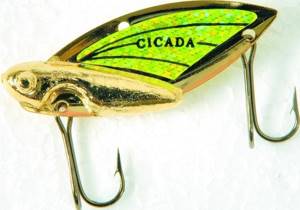
Spinnerbait
A spinnerbait is a wire “yoke”, with 1 or 2 blades attached to one arm, and a head with a hook to the other.
The hook itself is disguised with a silicone “skirt”. It is this silicone that attracts perch. To catch perch, give preference to spinnerbaits weighing up to 12 grams and having 2 blades.
The color of the bait should be chosen in the same way as for other spinners.
Jig lures
Jig baits are one of the most popular spinning baits for catching perch. When choosing a jig head, we recommend paying attention to three characteristics:
- Head shape;
- Weight;
- Hook size.
When fishing for perch using a spinning rod, only 2 types of jigs are used: a boot and a ball. A boot is preferable. Thanks to its streamlined shape, it plays attractively during step-by-step wiring, and snags are practically eliminated. The ball is a universal bait. It can be used in various bodies of water. But its disadvantage is that when “braking” the bait falls on its side.
You can buy twisters and jig worms from Chinese sites, for example Aliexpress, where delivery is carried out to all CIS countries: Kazakhstan, Ukraine, Belarus. These baits are actually consumables, so even if Chinese products suffer in quality, it will easily be worth the price. This option is also acceptable for those who live in remote areas where there are no specialized stores.
Choose the weight of the head so that your bait does not get carried away by the current.
When choosing a size, keep in mind that there must be a distance of at least 3 mm between the bait and the hook.
The most common jig baits when fishing with spinning rods are:
- Vibrotails;
- Twisters;
- Worms.
Choose the right color. Perch are attracted to fish of contrasting colors, such as red and white. The catch will be better if you choose “edible” baits instead of regular silicone.
Vibrotail Storm suspending wildeye
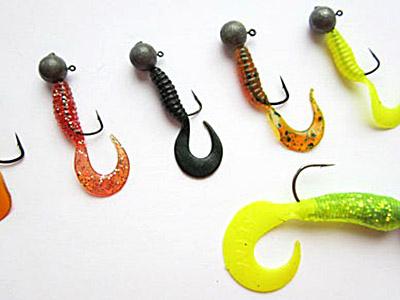
Micro twister
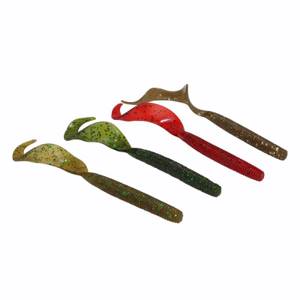
Jig worm
Wobblers
The best option for catching perch with a spinning rod is a minnow wobbler. It is their small size and bright coloring that actively attracts predators. As a rule, wobblers no more than 5 centimeters long are chosen for perch hunting. However, if large fish are expected to bite, the length of the bait can be 7-9 centimeters. It’s also worth taking a closer look at poppers, the size of which, when fishing for small and medium-sized specimens, should be no more than 4-5 centimeters. For large individuals the sizes are 5-8 cm, respectively.
Despite the fact that perch is attracted mainly by the play and maneuverability of wobblers, it is worth paying attention to their color. Before using bait, evaluate the water quality in the pond. If it is cloudy, opt for baits of acidic colors. This will make it easier for perch to detect it. If the water is clear, take wobblers of natural and dark colors. Also, for fishing in the water column, it is worth using wobblers of acidic colors, while surface play requires wobblers of duller colors.
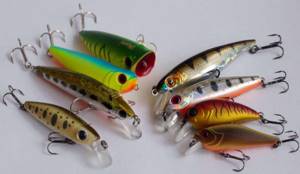
Lures for catching perch
Perch fishing is carried out using spinning baits of all types, but most often spinners, wobblers and silicone baits are used for catching perch.
Spinners
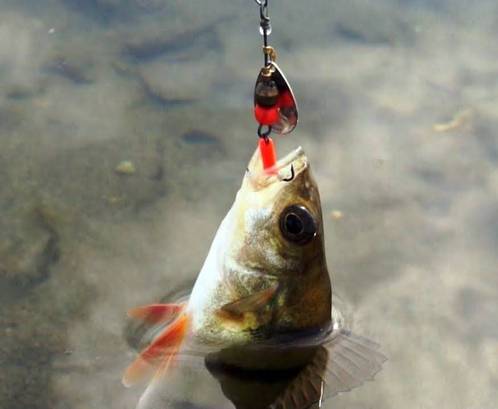
Rotating spoons differ in weight, size, shape and color of the petal.
At shallow depths, back-loaded spinners are used, with a weight of 1 to 8 g, the petal size of which, according to the Mepps classification, is 0-3. For fishing at a depth of 2 meters or more, use front-loaded spinners with a petal number 2-4, guiding the spinner with a stepped retrieve at minimum speed. In sunny weather, baits without glitter are effective, but in cloudy weather it is better to take sparkling ones - silver or golden.
You may be interested in: Grayling
Wobblers
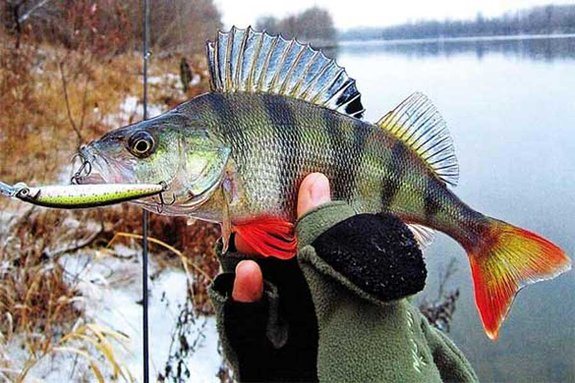
When choosing a wobbler, pay attention to its size and diving depth. The most effective bait is one that goes to the fishing spot near the bottom. The use of deep-sea wobblers with a long blade, going near the bottom, is effective in large bodies of water; for fishing, a floating wobbler is used, throwing it deeper than the fishing point. If a school of perch is located at the surface of the water or in the middle layer, use wobblers with a shallower working depth. The most effective are minnow class wobblers, 5-6 cm in size, the animation of which is created by the spinning player with his play. Brightly colored wobblers are used in muddy water, as well as for fishing at depth. For surface play and in clear water, wobblers of dark and natural colors are more suitable.
Silicone baits
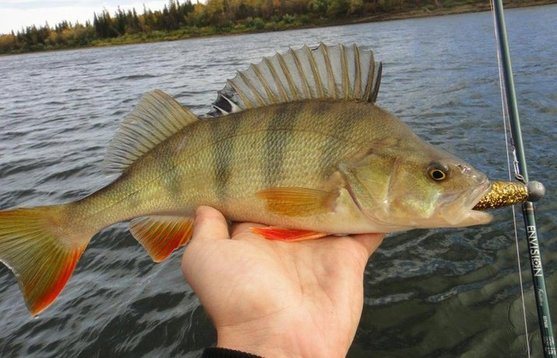
Such baits are made from a material that is more durable, elastic and environmentally friendly compared to rubber. Products come in a variety of shapes, colors and smells, and can be edible or inedible. Advantages of silicone baits:
- They perfectly imitate worms and fry, actively playing in the water;
- Streamlined shapes, keeps them from getting caught on snags and water plants;
- They cost less than wobblers and spinners.
For perch fishing, the dimensions and shape of the bait are important - the characteristics by which a predator chooses a prey. There are two types of silicone baits:
- Active, characterized by pronounced play on a uniform retrieve. These include:
- vibrotail, similar to a small fish (for perch they take it with a tail shaped like a hoof);
- twister with a ribbed oblong body, like a worm, and a tail in the shape of the letter G;
- frog with legs.
2. Passive ones, which play thanks to the actions of the fisherman:
- slug in the shape of a worm, effective when fish have reduced activity;
- fringed frog;
- crustaceans used in thickets and snags.
Recommended sizes:
- 8-10 cm - for catching large perches
- 6-8 cm - for medium-sized perches
- 3-5 cm - for catching small perch
Silicone lures of bright colors are effective in muddy water, and dark colors are effective in transparent water. Aromas that attract perch:
- fish;
- meat;
- garlic;
- shrimps.
Variations of rigs
Texas rig
Perch, pike, and pike perch are caught using Texas rigs. Therefore, we can say that it is quite universal.
Texas equipment consists of:
- Silicone bait or worm;
- Bullet sinkers;
- Offset hook;
- Beads.
Equipping such equipment is extremely simple, so even a novice fisherman can handle it. Assembly instructions:
- Place the sinker on the main line so that its narrowed part faces the rod;
- For shock absorption, place a bead on the fishing line;
- Tie an offset hook;
- Place a suitable bait on the offset.
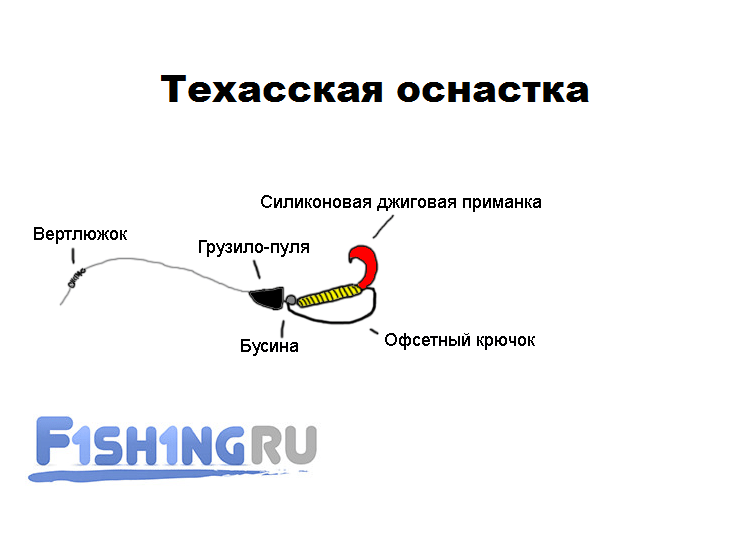
Drop shot
The essence of the drop-shot rig is to play the bait in the water column. To do this, the line should be positioned diagonally from top to bottom.
To assemble the equipment, attach a sinker to the free end of the fishing line. The most optimal weight would be 10 grams. Then tie an offset hook just above the sinker (20-30 centimeters). Now attach the desired bait to the hook.
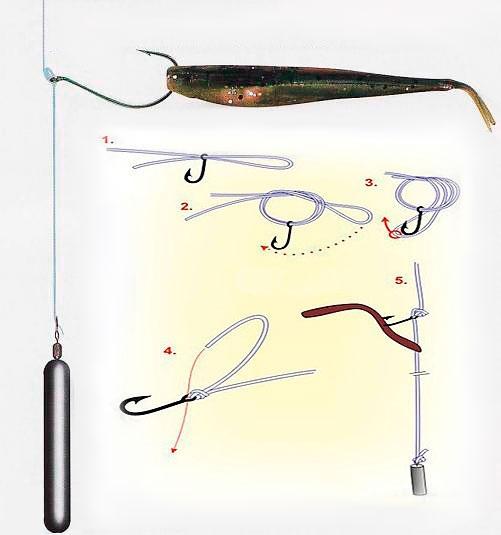
Retractable leash
The rig's rig is reminiscent of a drop-shot. It is necessary to tie a 15-20 gram sinker to the free end of the fishing line (in the case of a microjig - 3-6 g). Then attach a meter-long leash at a distance of 30 centimeters from it. And attach a jig bait with an offset hook to its end.
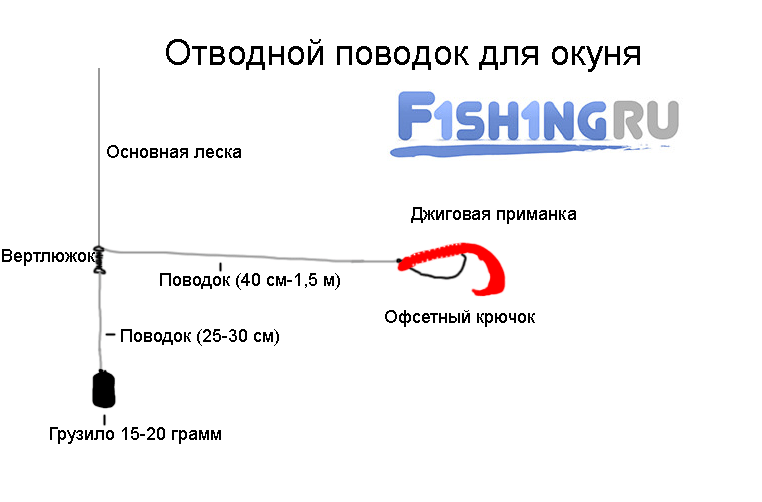
Jig equipment
Jig equipment has always been and will be the most effective for catching perch with a spinning rod. It is extremely easy to equip. There are 2 ways to install it:
- Rigid mount. It is necessary to attach the bait to the jig head so that the sinker is in front of the silicone, and the hooks are located on top.
- Flexible mount. The installation technology is exactly the same as with rigid mounting. The difference is that the hook is attached to a sinker (Cheburashka type) by means of a winding ring. This is what allows the bait to play when retrieving.
Spinning rigs for perch
Experienced fishermen mainly use several types of equipment:
- Spaced equipment. The load and bait in these are widely separated, usually with the help of a leash.
Among the spaced rigs, the following are especially popular: Caroline. When the bait is at the end of the line and the load is suspended above. Moscow. It's the other way around. The weight is on the end, and the bait is on the leash a little higher. This equipment is called a diverter leash.
- Dropshot. A very popular rig for spot fishing. The peculiarity is that the sinker is placed at the end of the fishing line, and half a meter from it, a hook is attached directly to the fishing line.
In terms of equipping a spinning rod for catching perch, everything is equipped with the classic method:
- the reel is attached to the spinning rod;
- the fishing line is threaded through all the rings from the smallest to the largest, then the end is attached with an ordinary knot to the spool and the fishing line is wound almost to the very edge of the spool (it is necessary to leave a little less than 1 mm so that the fishing line does not fly off spontaneously);
- It is better to attach a single bait through a swivel with a clasp (carabiner) so that the line does not twist (this is especially important for rotating spoons);
- if you are using braided fishing line, and the rig (one of those we discussed above) requires a leader, take fluorocarbon line, it is invisible in the water and is ideal as a leader material;
Choosing a fishing spot
The habitat of perch changes throughout the seasons. It depends on the movement of small fish - the main food of the predator. Below we will look at where the fish live depending on each time of year.
- Spring. It is in the spring that white fish begin to spawn. The fish prefers to spawn in shallow water, so perch can also be found there.
- Summer. In summer, small predators prefer to live in thickets. A snagy bottom, thickets of water lilies, and reeds are the places where you can find small perches. On hot sunny days, fish like to hide under cliffs and bridges. Larger individuals can be found in more hidden places, for example, in pools. And large perches come out to feed at dusk.
- Autumn. In the fall, the white fish that perch feed on move deeper into the water bodies due to the fact that this is where the heated water is located. The predator rushes after her. He spends almost the entire winter at the bottom.
Techniques for catching perch using a spinning rod
From the shore
Although fishing from the shore is the most popular among anglers, it limits spinners in choosing a fishing spot.
Both jig baits and spoons are equally suitable for fishing.
For jig fishing, it is better to use stepped fishing. It should be carried out evenly for better bait play. Perch also responds well to jerking retrieves. But when using wobblers, it is recommended to use twitching wiring.
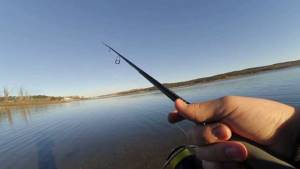
From the boat
From a boat it is necessary to cast the bait downwind and reel at medium speed. As a rule, wobblers are used for fishing from a boat. They are the ones who know how to play interestingly at depth. But with silicone baits you can also expect a good bite.
Fishing method
To get a bite you need to tease the perch. To do this, you need to lower the bait to the bottom (avoid grass), and then very smoothly raise it 30-40 centimeters. After this, sharply lower it by 20-40 centimeters. Such cycles should be repeated 6-8 times. If bites have not yet occurred, then you need to pause for 5 seconds. And then repeat each cycle with a delay. If after 20 repetitions there is no bite, you need to look for another place.
Video on catching perch with wobblers using the twitching technique
Bite
A perch bite can be noticed by a slight push and knock on the spoon. At the same time, the nod seems to shudder and bend a little. After each push, it is necessary to make a gentle upward hook in order to secure the fish on the hook.
Sweeping
To properly hook, you need to know two rules:
- On rivers with a current, hooking must be done instantly so that the fish does not have time to spit out the bait.
- At the depths of stagnant bodies of water (lake, pond), you need to wait time before starting to hook fish.
In this case, the fishing line must be stretched so that you can catch the perch with a slight movement of your hand.
Fishing
The secrets of the fishing technique are simple:
- The line should be as tight as possible. If you give even a little slack, the fish can easily free itself from the hook.
- For effective fishing, it is better to use a friction clutch. It will allow you to keep the line as taut as possible, but will not allow it to break.
- At the very beginning of fishing, take the fish to the upper layers of the reservoir , so you will not allow it to hide among the snags.
- As soon as you bring the fish to the surface of the reservoir, use a landing net. It will help you avoid line breakage and loss of fish.
Watch a video about catching perch using a spinning rod from a boat:
Wiring
Uniform
Even a novice angler can cope with uniform spinning. In general, it is better to start learning with it. For this, the spinner just needs to rotate the reel evenly.
Ryvkova
Another name for jerk wiring is twitching. Wobblers are usually used for this. With sharp jerks, such a bait is capable of creating high-frequency vibrations. The frequency of jerks and amplitude will depend specifically on the activity of the fish.
Stepped
In this case, it is customary to use jig baits. Stepped wiring can be safely called bottom wiring.
For step retrieving, you need to throw the bait so that an angle is formed between the spinning rod and the fishing line. After the bait sinks to the bottom, you need to make 2-3 turns with the reel to raise it a little. Then again wait until it sinks to the bottom and repeat.
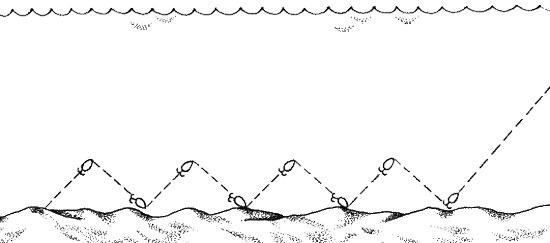
Stop and go
This wiring differs in that during it it is necessary to maintain pauses. When retrieving the bait, you need to take short pauses and then reel in.
wavy
This is a type of retrieve where the jig bait does not touch the bottom. That is, jerks occur in the water column.
To perform a wave-like retrieve, it is necessary to count the time during which the bait sinks to the bottom. And then gradually reduce it.
Selecting and equipping a spinning rod for perch fishing
For perch hunting to be successful, you need to choose the right spinning rod and equipment. How to do it?
Rod
Ultralight and light models with a test range from 2 grams to 14 grams are suitable for perch fishing. For fishing from the shore, you need to take rods from 2.4 meters to 2.7 meters in length, from a boat or from the shore overgrown with bushes and trees - from 1.8 meters to 2.4 meters in length. Ultralight spinning rods are used when predator activity is low or for catching large specimens. The action of the rod should be medium-fast, fast, super-fast. These forms work with a wide range of baits and allow you to use different fishing techniques.
Reels
For perch hunting, it is better to use medium-sized spinning reels on a spinning rod. It is important that the line is laid evenly and tightly on the spool. When fishing for this predator, the wiring is carried out unevenly. If the line is laid unevenly, it may break when jerking. The reel friction brake must be precisely adjusted. Perch have weak lips. Efforts when fishing it will increase the risk of prey disappearing.
fishing line
For catching perch, monofilament and braided line are used. The second option is suitable for jigging at depth. Mono lines work with wobblers and spinners. Their diameter is selected taking into account the characteristics of the bait. In general, it ranges from 0.15 millimeters to 0.2 millimeters. The weight of perch usually does not exceed one kilogram. Thick cords are not recommended. They reduce the sensitivity of the blank and reduce the casting distance. Braids with a diameter of 0.08 millimeters to 0.1 millimeters will be the best option.
Leash
It is not recommended to use metal leashes when fishing for perch using a spinning rod. This predator is not able to bite the cord or fishing line. In addition, the presence of a metal leash negatively affects the number of bites. If the pond where you are fishing contains pike that can be caught on a spinning rod, the problem can be solved with the help of fluorocarbon leashes and leashes made of thin soft wire.
Lures
Perch can be caught with any bait. But their choice depends on the fishing method and fishing conditions.
1. Jig. This is the best method for bottom fishing in reservoirs without snags in the cold season. The type of jig heads is selected taking into account the current, depth, and test range of the form. Collapsible cheburashkas are suitable, allowing you to experiment with different hooks without changing the bait and providing a sweeping game. It is better to take a variety of silicone when fishing so that you can choose the most catchy bait. If you are hunting for large specimens, you can take a larger head. It will reduce the number of small fish bites.
2. Twitching. It is used on algae-filled, snag-filled and rocky ponds. In this case, many anglers prefer spinners. Even with slow retrieval, such baits are capable of creating vibrations with a decent amplitude. Particularly interesting for perch are spinners weighing 5 grams of silver or golden color. The shape of the petals is selected according to the flow speed. If it is large, you need baits with elongated petals. Wide petals are suitable for standing water. Spoons with oval petals can be used in both cases.
3. Fishing with wobblers. Wobblers are not as catchy as spinners and jig heads, but perch can bite on them too. Wobblers will become indispensable on reservoirs with a muddy bottom or at great depths, to which spinners cannot reach. The size of wobblers when hunting perch ranges from 5 to 7 centimeters. During the cold season, you can use a mine with jerk wiring with regular pauses.
4. Fishing in difficult conditions. For fishing in reservoirs overgrown with algae and water lilies, spoons with anti-slip closed hooks are used. If the hunt for perch occurs during low predator activity, a set of small oscillating spoons will be effective. It imitates a school of fry and attracts the attention of lethargic fish.
It is important that all spinning equipment is as balanced as possible.
Perch fishing at different times of the year
in spring
March. Fishing this month usually produces a very good bite. Hungry after hibernation, the perch in early spring is ready to bite on any bait.
April. Spring spawning period. At the very beginning of April, you can also note a good catch of perch. Then he starts hunting for white fish. At the end of April there is a lull. The predator begins spawning.
May. This month the perch finishes spawning, so fishermen can expect a good catch of the hungry predator. At the end of May, you can use medium and large size baits.
In summer
June. In the first month of summer, perch rushes after the fry. Therefore, you can often find flocks of these predators.
July. This month, fishing will become more effective in the morning and evening hours. Moreover, it is then that the perch gets out into the upper layers of reservoirs.
August. This month is the best for perch fishing. Then the predators gather in flocks and begin to feed intensively.
in autumn
September. If you plan to hunt large individuals, then you should do this in September. This is when the larger fish gather in schools. They live mainly along the coast.
October. In cloudy weather the bite decreases. But you can still hope for a good catch.
November. During this month, perch begins to adapt to the upcoming cold weather. Therefore, November is not the best time for perch hunting.

